This month’s Oil Investment Update we begin with the words that we used to summarize the situation in the previous update (on Jul 8, 2016). We summarized the situation in the following way:
In the recent few weeks oil bulls and bears fought battles between the barrier of $50 (the key resistance) and the green support zone based on the Apr and early May highs. After several unsuccessful attempts to move higher oil bears took control and crude oil closed yesterday’s session under its first important support zone. Thanks to yesterday’s drop, the oil-to-oil stocks ratio declined under both medium-term key support lines, invalidating earlier breakout. Similar invalidations of earlier breakouts we also noticed in the oil-to-gold and oil-to silver ratios. Additionally, crude oil priced in “other currencies” declined under its key support – the 50-day moving average, which stopped oil bears several times in the past. Taking all the above events into account and combining them with sell signals generated by almost all indicators, we think that the commodity will extend declines (…) in the coming week(s).
We also attached the bearish scenario:
(…) If the commodity extends declines from current levels, the first downside target would be the green support zone around $42.50-$43. If it is broken, oil bears may push light crude to the 200-day moving average (currently at $41.12) or even to the next support area created by the Apr low of $39 and the barrier of $40.
Looking at the current picture of crude oil, we see that oil bears pushed the commodity lower as we had expected. With this downward move, crude oil slipped slightly below the barrier of $40, reaching our downside target. Despite this drop, oil bulls managed to push light crude higher after the first Aug EIA weekly report showed a larger-than-expected decline in gasoline inventories. Although crude oil paused on Friday, weakened by a stronger greenback, the commodity extended gains on Monday as speculation of potential late-September freeze from OPEC affected positively investors’ sentiment. In this environment, light crude came back above $43 and invalidated earlier breakdown under short-term support. Will this event encourage oil bulls to act? Let’s jump right into charts (charts courtesy of http://stockcharts.com) and try to find answer to this question.
Crude Oil
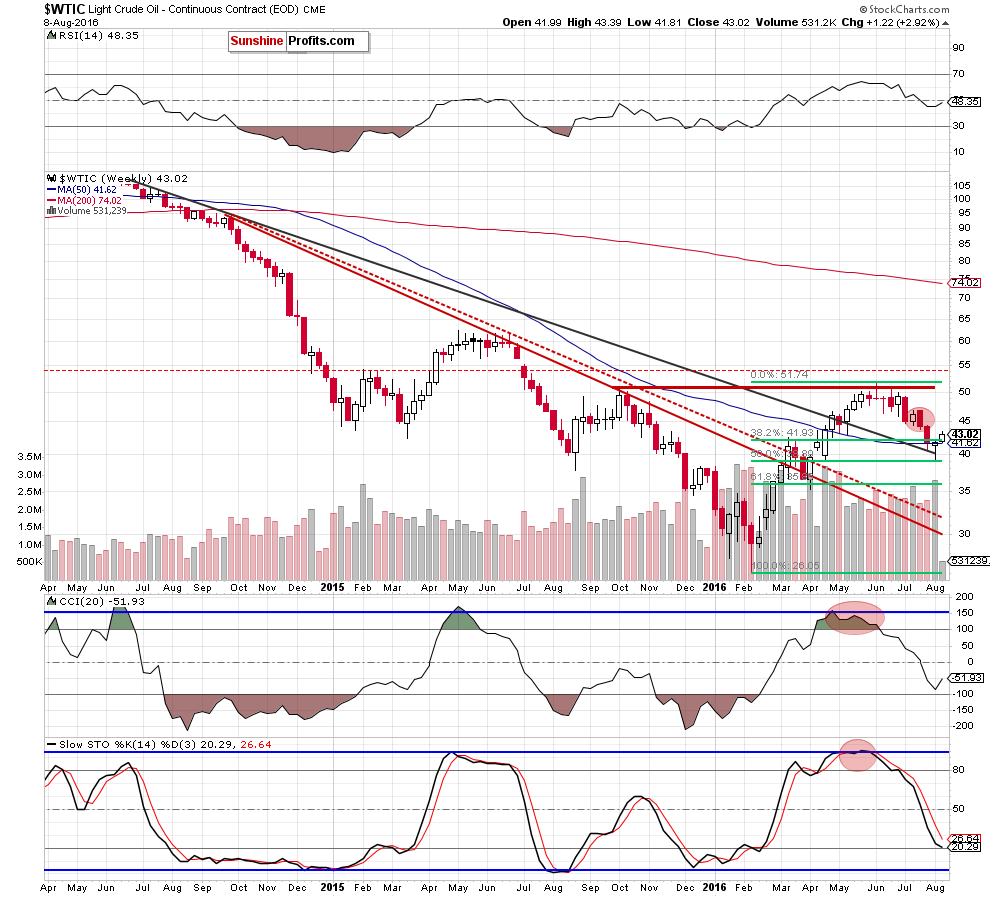
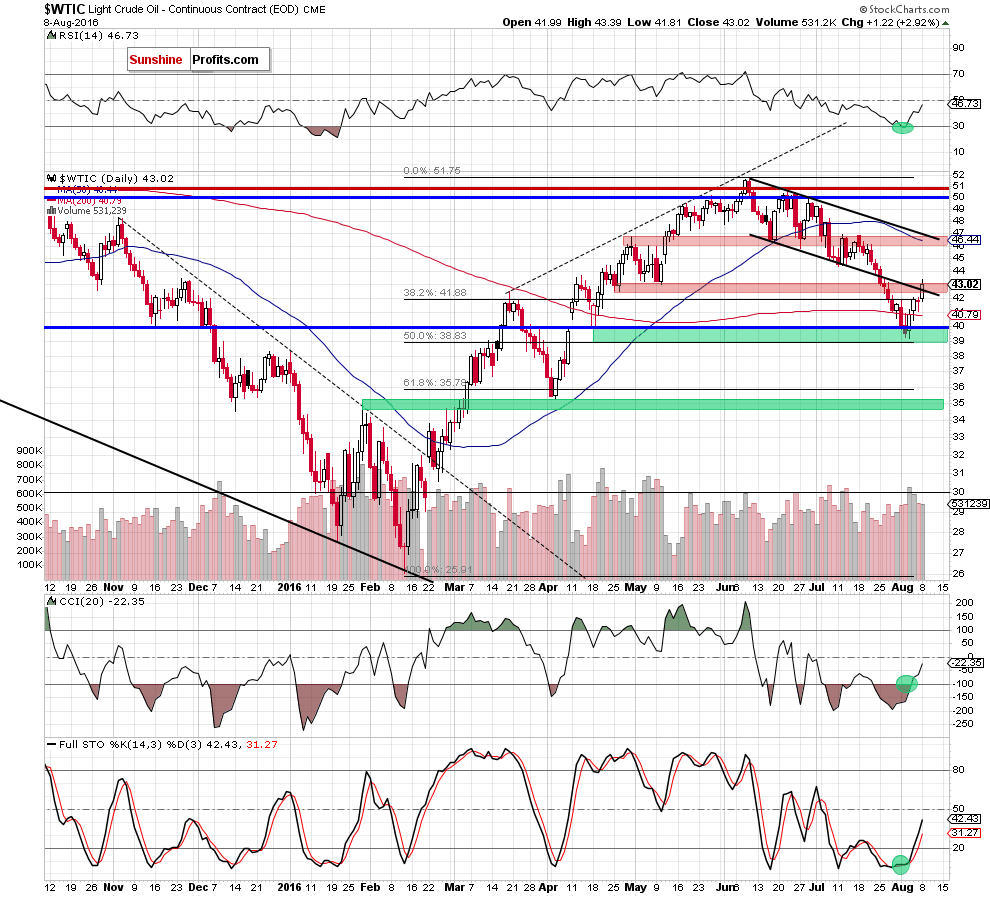
Looking at the daily chart, we see that the green support zone (created by the 50% Fibonacci retracement and the barrier of $40) encouraged oil bulls to act, which resulted in invalidation of the breakdown under the barrier of $40. In the following days, the commodity invalidated also earlier breakdown under the 200-day moving average, which in combination with a weekly closure above the long-term black declining line (marked on the weekly chart) and buy signals generated by the daily indicators suggested further improvement and a test of the previously-broken lower border of the black declining trend channel (currently around $42.70).
From today’s point of view, we see that with Monday’s increase the commodity not only increased to this upside target, but also climbed higher and closed the day above the lower border of the black declining trend channel. In this way, light crude invalidated earlier breakdown under this short-term support, which in combination with all the above-mentioned bullish factors suggests further improvement in the coming days.
If this is the case, and crude oil moves higher from here, we’ll see an upward move to (at least) the upper border of the black declining trend channel (currently around $46.90) in near future.
Summing up, crude oil invalidated earlier breakdown under this short-term support, which in combination with buy signals generated by the daily indicators and invalidation of the breakdown under the 200-day moving average and a weekly closure above the long-term black declining line suggests a test of the upper border of the black declining trend channel (currently around $46.90) in the coming days. Therefore, we believe that opening long positions is justified from the risk/reward perspective.
Having discussed the situation in crude oil, let’s examine the NYSE Arca Oil Index (XOI) to find out what the current outlook for oil stocks is.
Oil Stocks
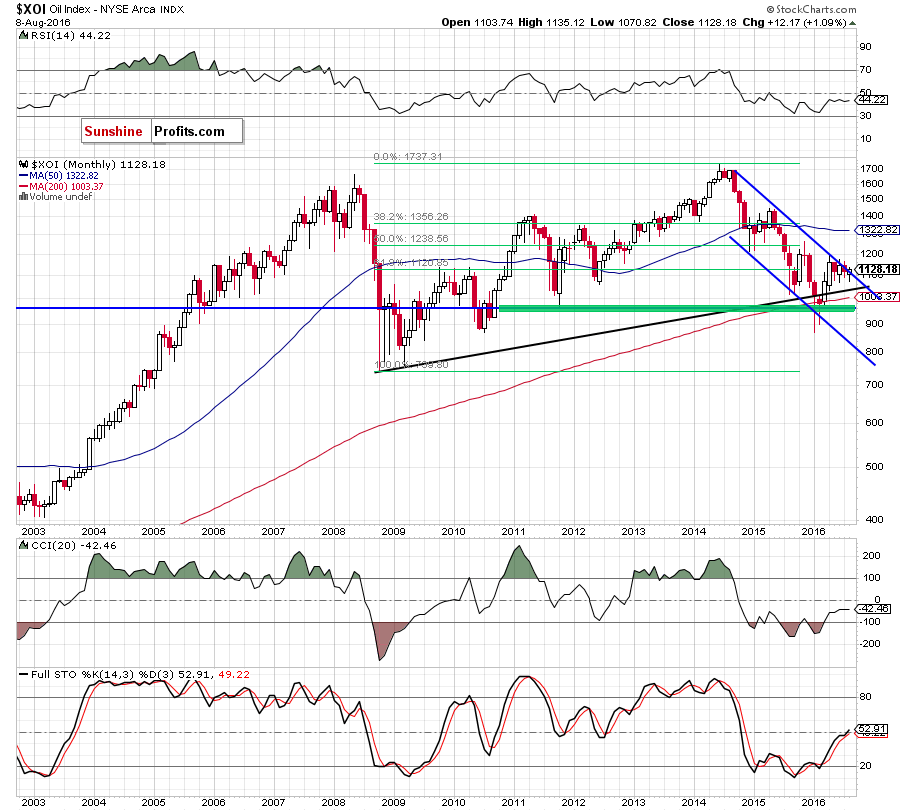
Looking at the monthly chart, we see that oil bulls pushed the XOI above the upper border of the blue declining trend channel. Although this is a positive signal that suggests further improvement, we should keep in mind that we saw similar price action several times in previous months. Therefore, in our opinion, as long as there won’t be monthly closure above this important line, another attempt to move lower can’t be ruled out.
Will the medium-term chart give us more clues about future moves? Let’s examine the weekly chart and find out what can we infer from it.
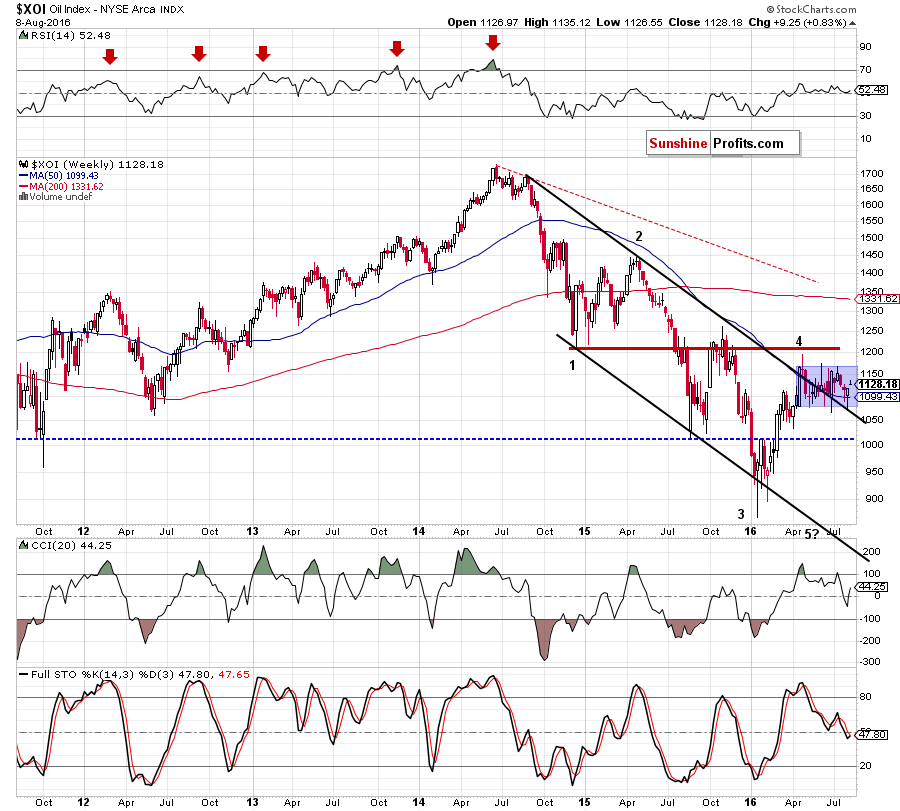
From this perspective, we see that the overall situation hasn’t changed much since our previous Oil Investment Update was posted as the XOI is consolidating between the upper border of the black declining trend channel and the Jun and Jul highs. This means that as long there won’t be breakout above the upper line of the formation (or a breakdown under the black support line) another bigger move is not likely to be seen.
Having said the above, let’s check the very short-term chart.
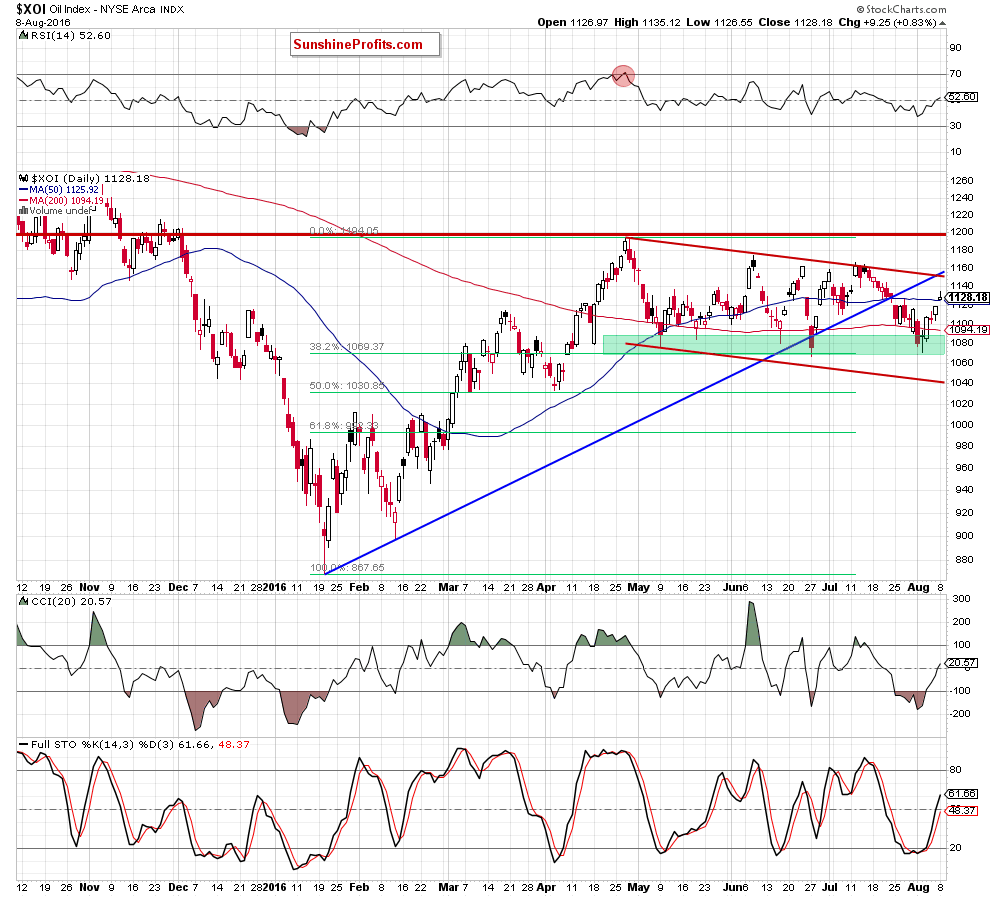
On the daily chart, we see that the green support zone in combination with the 38.2% Fibonacci retracement level (based on the Jan-Apr rally) encouraged oil bulls to act once again, which resulted in an upward move that took oil stocks above the previously-broken 50-day moving average. In this way, the XOI invalidated earlier breakdown, which in combination with buy signals generated by the indicators suggests further improvement and (at least) a test of the upper border of the red declining trend channel. At this point, it is worth noting that this solid resistance was strong enough to stop oil bulls in the previous month. This suggests that we may see similar price action after increase to this key resistance line in the following days. If this is the case, and oil stocks decline from here, the initial downside target would be the 38.2% Fibonacci retracement level and the Jun low of 1,067.
Summing up, although oil stocks rebounded in recent weeks, they are still trading in the blue consolidation marked on the weekly chart. Therefore, in our opinion, as long there won’t be breakout above the upper line of the formation (or a breakdown under the black support line) another bigger move is not likely to be seen and short-lived moves in both directions should not surprise us.
Ratio Analysis
Today, we start this section by focusing on the oil-to-oil stocks ratio. What can we infer from the chart below?
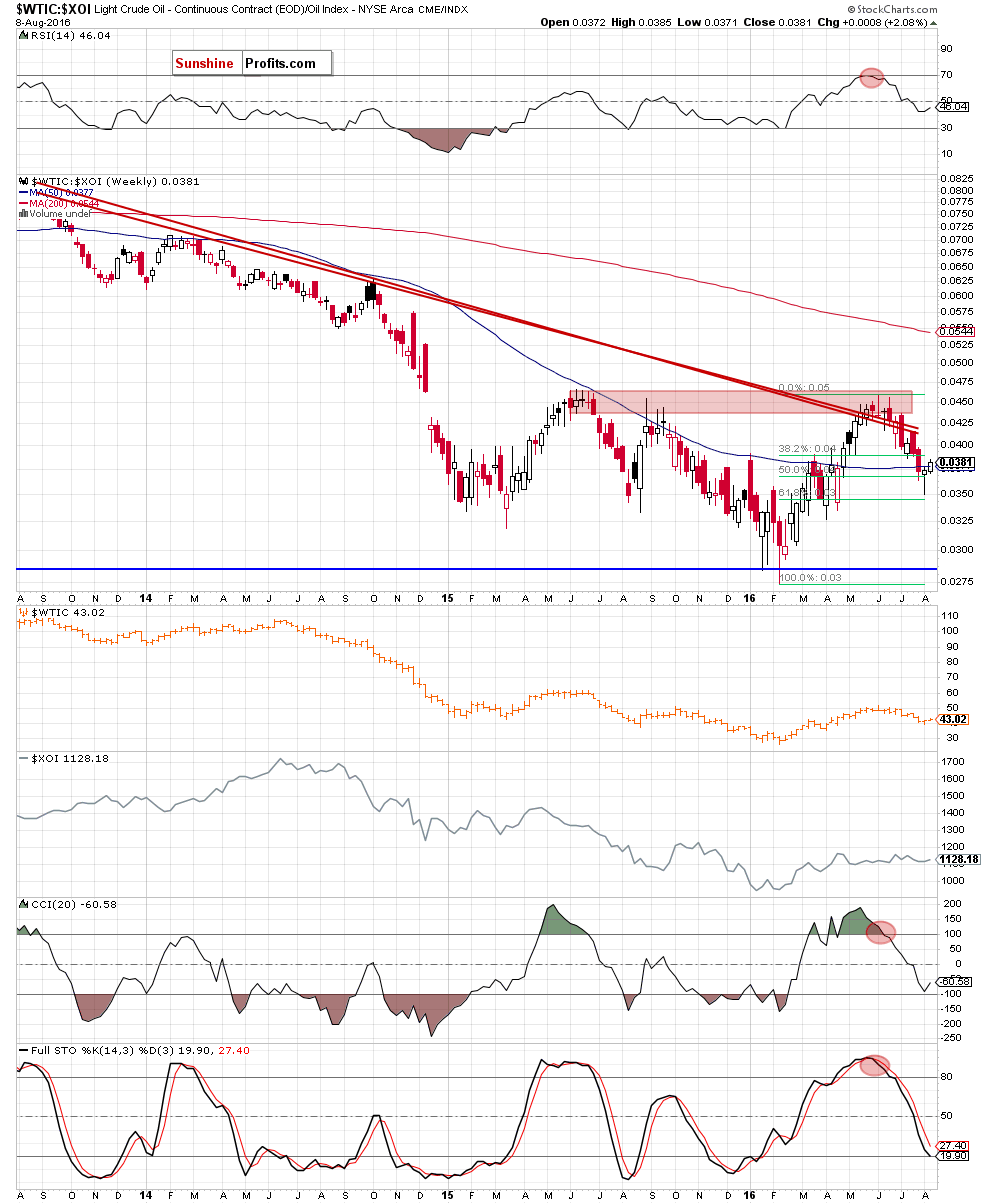
A month ago, we wrote the following:
The first thing that catches the eye on the above chart is breakdown under both red declining support lines, which is a negative signal that suggests further deterioration in the coming week(s) – especially when we factor in sell signals generated by the CCI and the Stochastic Oscillator. What does it mean for light crude? As you see on the above chart, there is a strong positive correlation between the ratio and crude oil, which means that lower values of the ratio will translate into lower prices of the commodity – similarly to what we saw in all cases in the past.
From today’s point of view, we see that the situation developed in tune with the above scenario and the ratio (in line with crude oil) extended losses in recent weeks. With this downward move, the ratio declined under the 50-week moving average and approached the 6.8% Fibonacci retracement. As you see, the proximity to this support level encouraged oil bulls to act, which resulted in a rebound. Thanks to the current upward move, the ratio invalidated earlier breakdown under the above-mentioned moving average, which is a positive signal that suggests further improvement and a test of the previously-broken both red declining lines, which serve as the nearest medium-term resistance. If this is the case and we’ll see higher values of the ratio, such price action will translate into higher prices of crude oil in the coming week(s).
Will the oil-to-gold ratio confirm this scenario? Let’s check the chart below and find out.
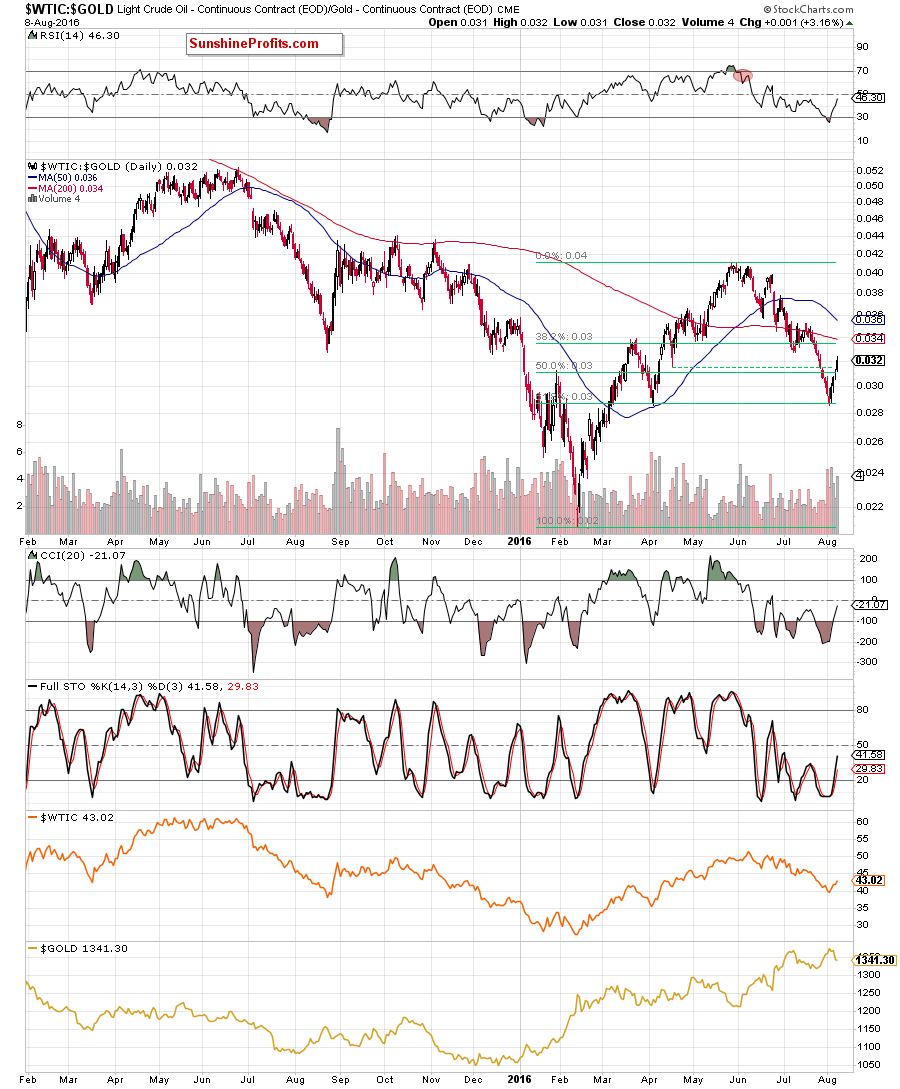
Quoting our previous Oil Investment Update:
(…) the ratio extended losses in recent days, which resulted in a drop under the 200-day moving average. Additionally, the ratio closed yesterday’s session below it, which is an additional bearish signal. On top of that, a sell signal generated by the Stochastic Oscillator remains in play, supporting further deterioration in the coming days.
On the above chart, we see that the ratio extended losses as we had expected. With this downward move, it slipped to the 61.8% Fibonacci retracement, which triggered a rebound earlier this month. Additionally, the CCI and Stochastic Oscillator generated buy signals, which suggests further increases and (at least) a test of the previously-broken 200-day moving average in the coming days.
What impact did this move have on the weekly chart? Let’s check.
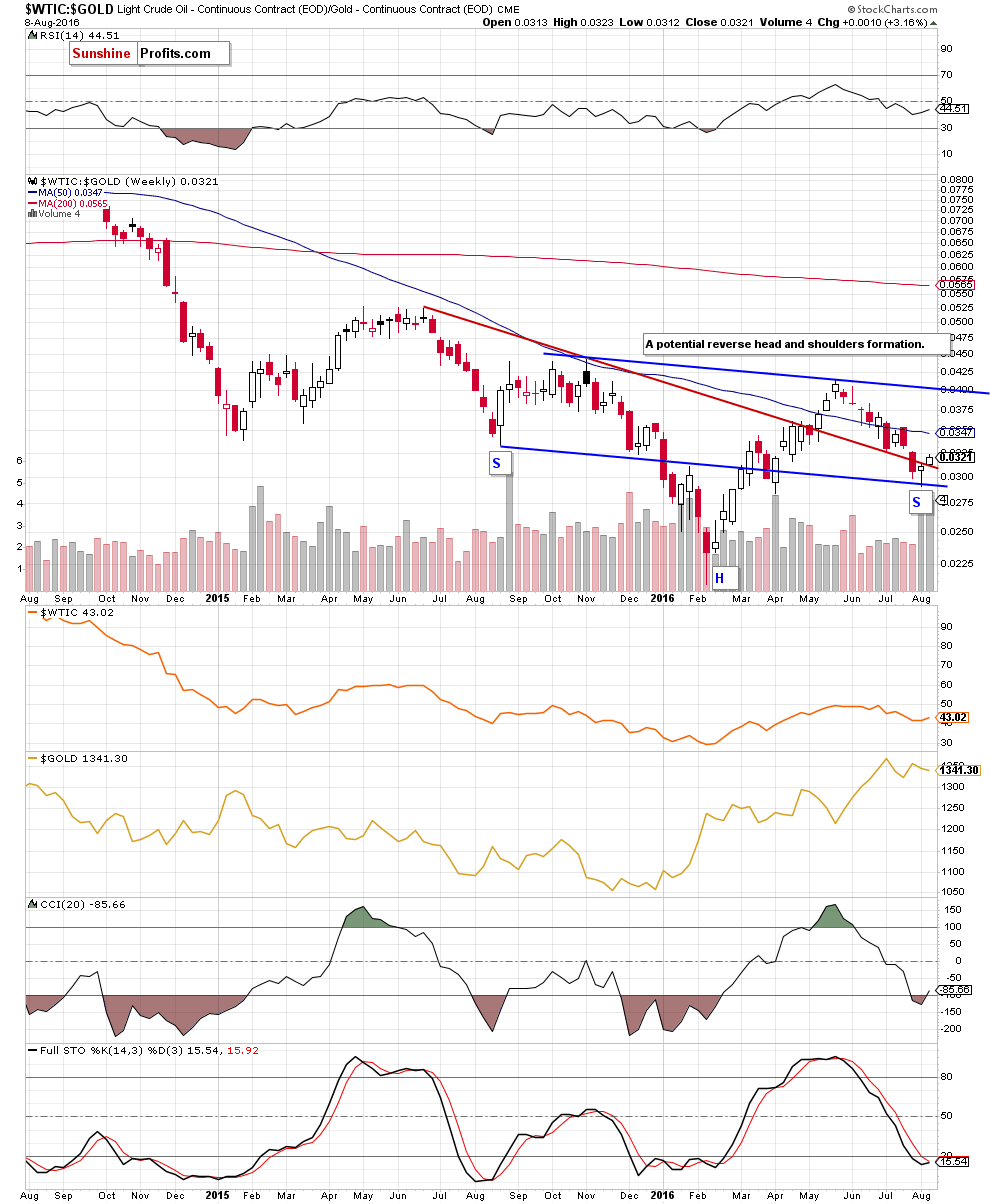
In our previous update, we wrote:
(…) the ratio declined under the 50-week moving average, which in combination with sell signals generated by the CCI and Stochastic Oscillator is another pro bearish factor that suggests further deterioration in the ratio. What impact such price action could have on crude oil? Similarly to what we wrote in the case of the oil-to-oil stocks ratio, there is a strong positive correlation between the above ratio and the price of crude oil. Therefore, another downswing in the ratio will correspond to another drop in the commodity.
Looking at the weekly chart, we see that the situation developed in line with the above scenario and the ratio moved lower in Jul, closing the month under the long-term red declining support line (based on the Jun and Nov 2015 highs). This negative event triggered further deterioration in the previous week, which resulted in a drop to the lower blue support line (parallel to the upper line based on the Nov 2015 and May 2016 highs). As you see, this support encouraged oil bulls to act, which pushed the ratio above the long-term red declining line. In this way, the ratio invalidated earlier breakdown, which suggests further improvement (nevertheless, this signal would be more valuable if the ratio closes this week above the red line) – especially when we factor in the current position of the indicators (the CCI generated a buy signal, while the Stochastic Oscillator is very close to doing the same).
Before we move to the next ratio, it is also worth noting that the recent drop and rebound may create the right shoulder of a potential reverse head and shoulders formation. However, this pro growth pattern would be more reliable and valuable if the ratio climbs above the upper blue line, which ay be a neck line of this formation.
Having said the above, let’s check what we can infer from the oil-to-silver ratio.
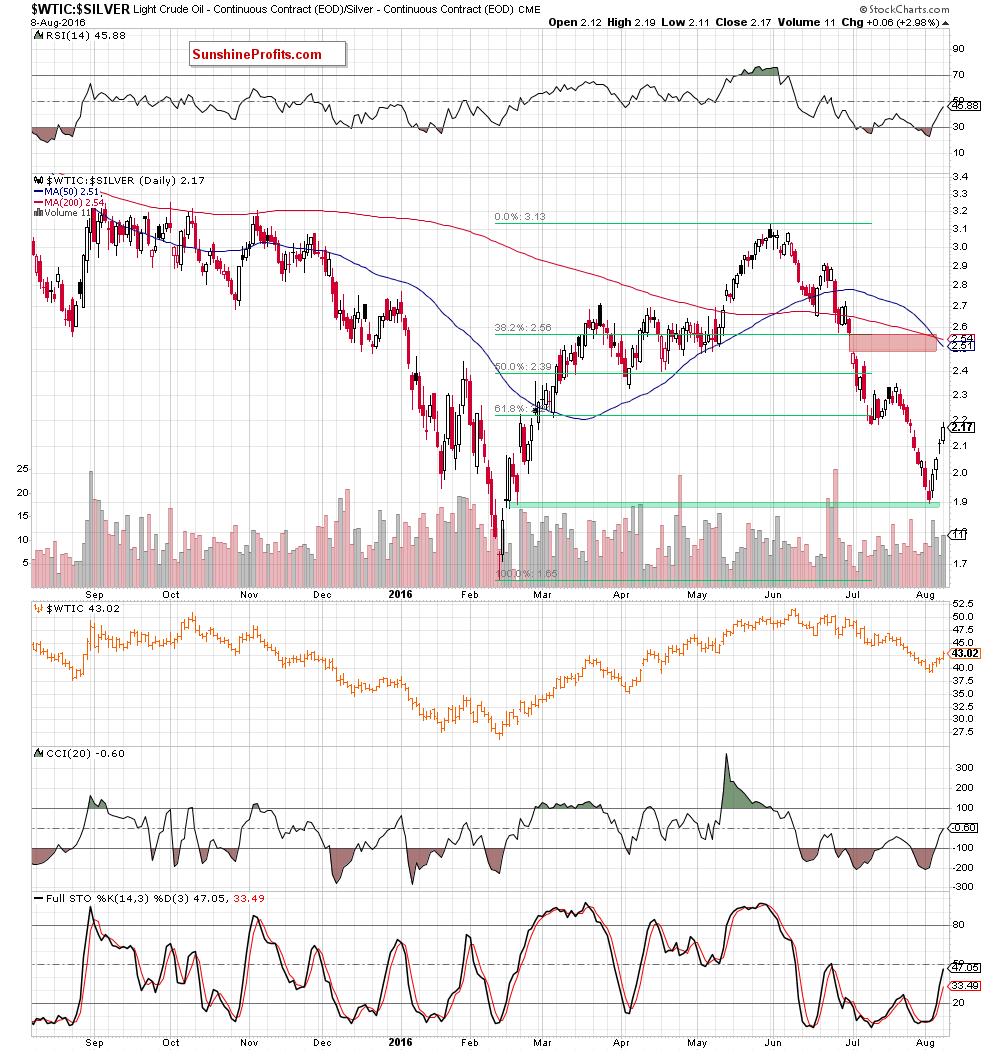
Quoting our last update:
(…) the breakdown under the 200-day moving average accelerated declines, which resulted in a bearish gap (marked with red) and further deterioration in recent days. Thanks to yesterday’s drop the ratio declined under the Apr low and closed the day below it, which is a negative signal that suggests (at least) a test of the 61.8% Fibonacci retracement based on the entire Feb-Jun upward move. If this is the case, and we see such price action, lower values of the ratio will translate into lower prices of crude oil – similarly to what we saw many times in the past.
On the daily chart, we see that the ratio declined in the previous weeks (in line with our assumptions), which resulted in a drop to the green support zone created by the mid-Feb lows. Despite this deterioration, the ratio bounced off this area, which in combination with buy signals generated by the daily indicators suggests continuation of the upward move and (at least) a climb to the Jul 20 high in the coming days. How such increase may affect the short-term picture of crude oil? Taking into account positive correlation between the ratio and the commodity, we think that higher values of the ratio and crude oil are just around the corner.
Once we know the relationship between crude oil and precious metals, let’s take a closer look at the oil-to-stocks ratio.
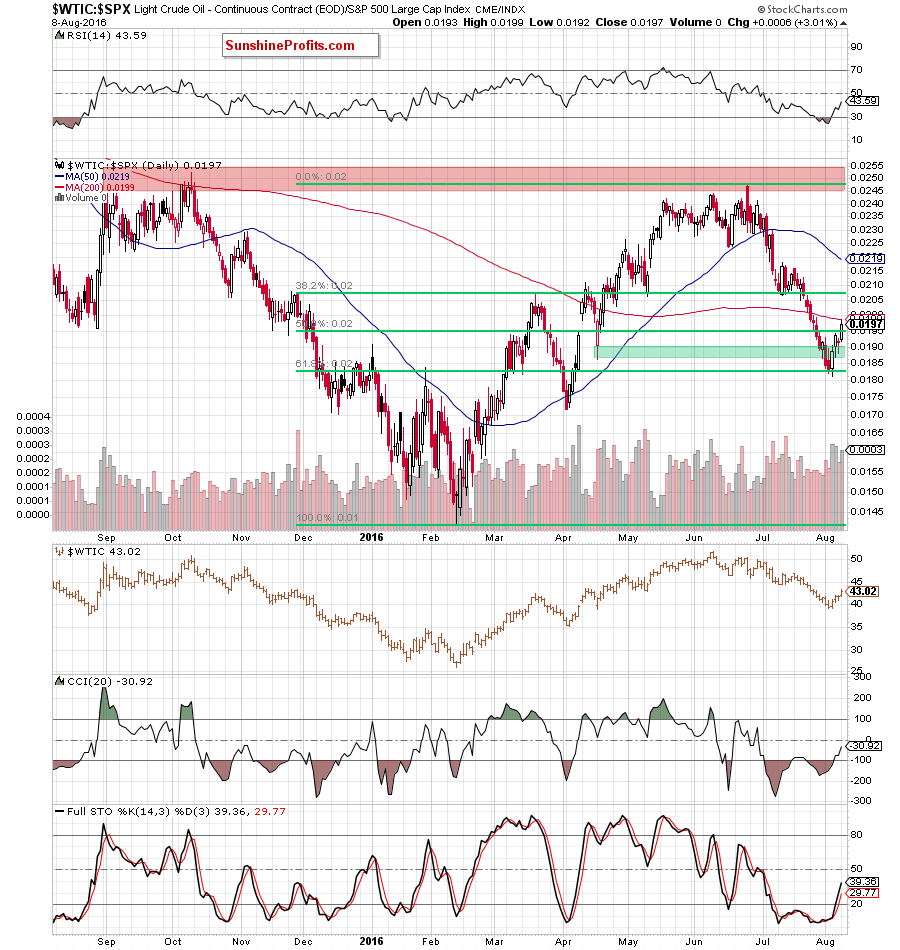
From the very short-term perspective, we see that the ratio bounced off the 61.8% Fibonacci retracement and came back above the green support zone, invalidating earlier breakdown. With this upward move, the ratio reached the previously-broken 200-day moving average, which may pause further rally. Nevertheless, the current position of daily indicators (they all generated buy signals) suggests that higher values of the ratio (and crude oil as positive relationship remains in place) are just around the corner.
Will the medium-term picture confirm this positive scenario? Let’s check.
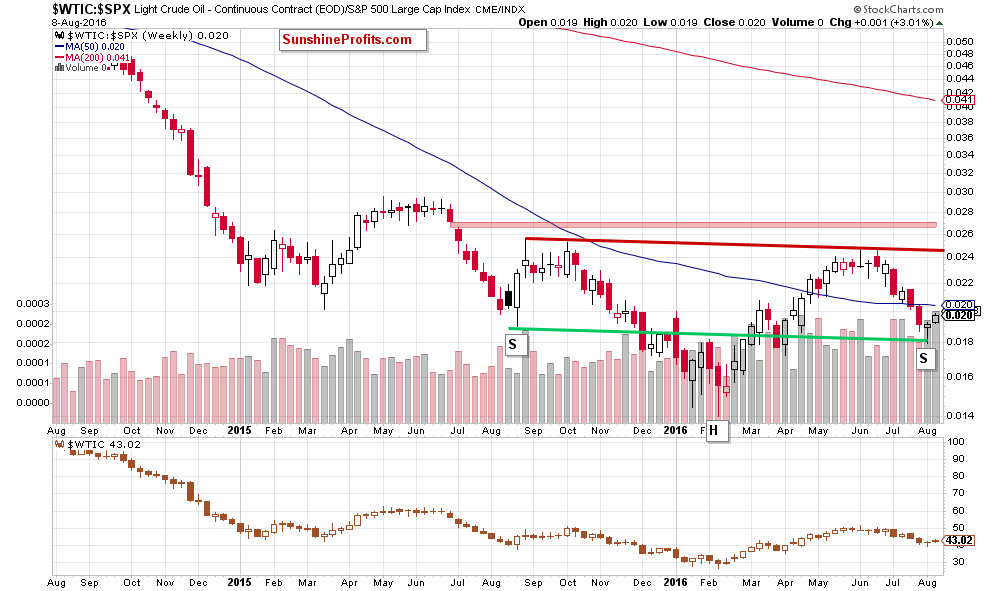
On the weekly chart, we can notice a potential reverse head and shoulders formation. Similarly to what we wrote in the case of the oil-to-gold ratio, we may see emergence of the right shoulder in the coming weeks. Therefore, if the ratio extends gains from here, the price of crude will also move higher.
Non-USD Crude Oil Price
Finishing today’s Oil Investment Update, let’s take a closer look at the non-USD (WTIC:UDN ratio) chart of crude oil once again. As a reminder, UDN is the symbol for the PowerShares DB US Dollar Index Bearish Fund, which moves in the exact opposite direction to the USD Index. Since the USD Index is a weighted average of the dollar's exchange rates with world's most important currencies, the WTIC:UDN ratio displays the value of crude oil priced in "other currencies".
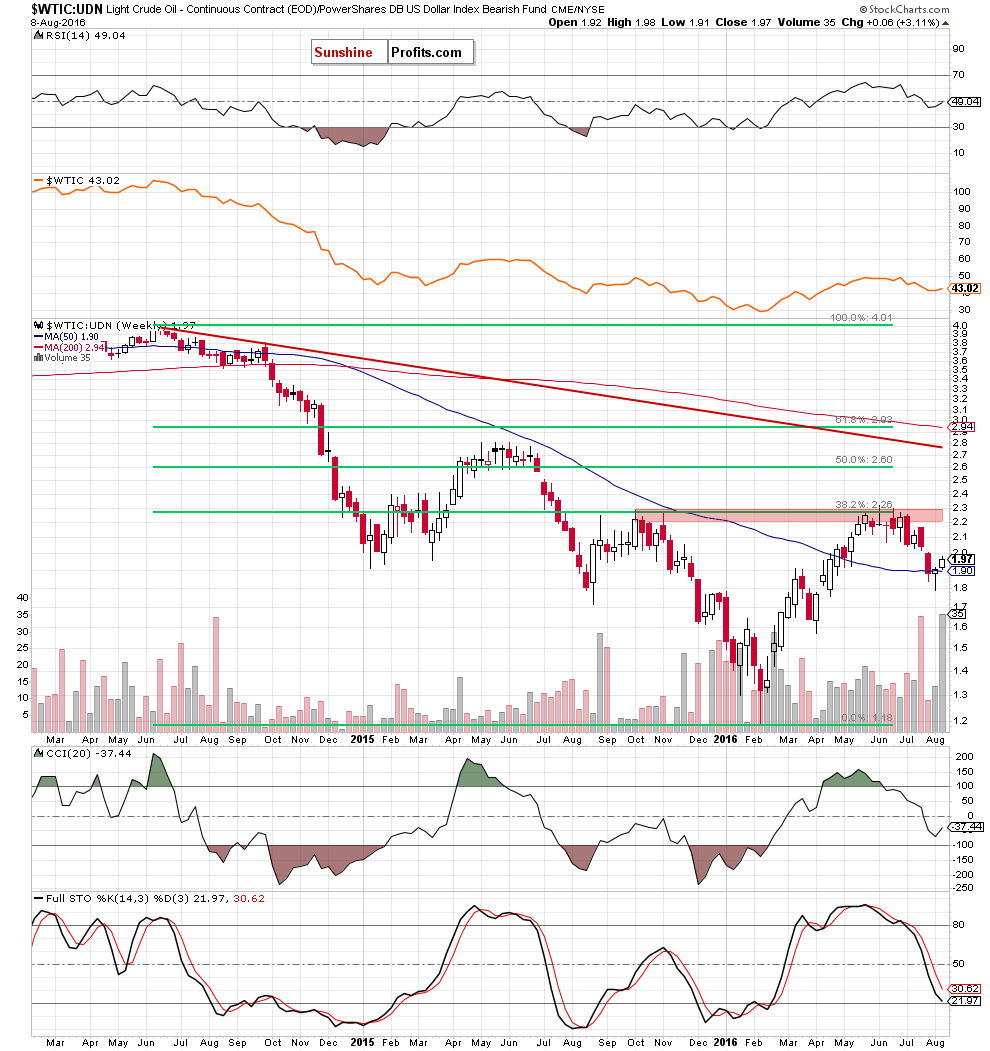
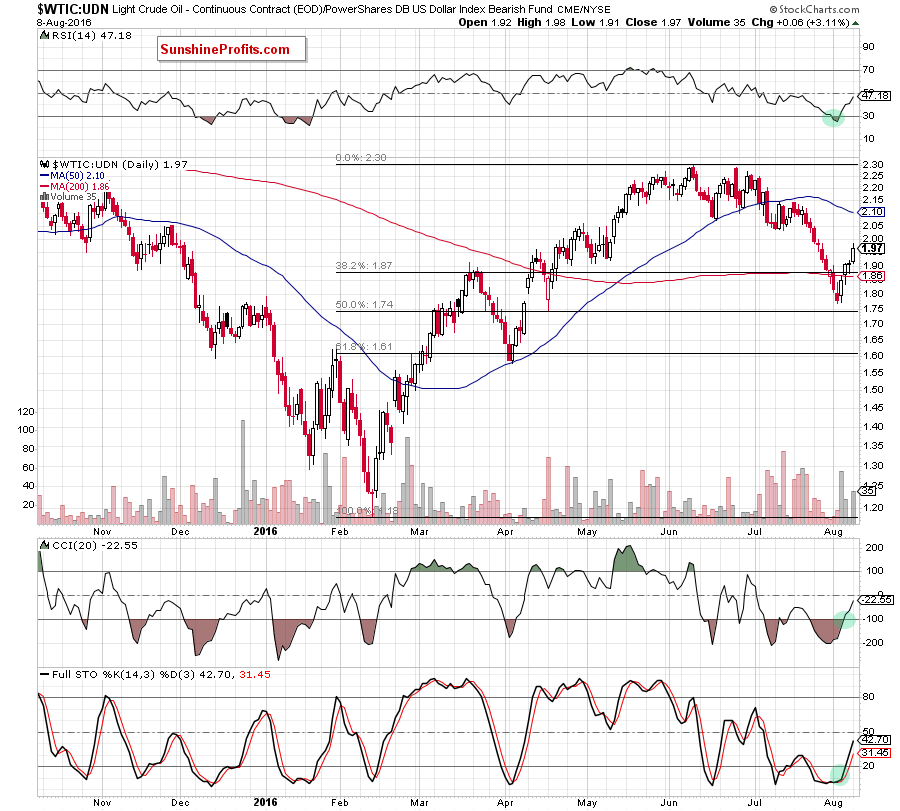
A month ago, we wrote:
(…) the red resistance zone (created by the Oct and Nov highs and the 38.2% Fibonacci retracement based on the entire Jun 2014-Feb 2016 downward move) stopped oil bulls and triggered a pullback in recent days. Taking this fact into account and the current position of the indicators (the CCI and Stochastic Oscillator generated sell signals), we think that further deterioration (and at least a test of the 50-week moving average) is just a matter of time. If this is the case, and the ratio extends declines from here, well also see lower prices of crude oil in the following week(s).
From today’s point of view, we see that the ratio extended losses as we had expected. With the recent downward move, it not only reached our downside target, but also slipped below it. However, as you see, this deterioration was only temporary and the ratio invalidated the breakdown very quickly. Taking this fact into account and combining it with buy signals generated by all daily indicators, we think that higher values of the ratio and light crude are just a matter of time.
Scenarios
Just like a month ago, today’s Oil Investment Update includes scenarios of what could happen in the coming weeks. Naturally, we will continue to monitor the market in the coming days and if anything invalidates our long-term outlook we will send you an additional message.
- Bullish scenario
If crude oil extends gains, the initial upside target would be the upper border of the black declining trend channel marked on the daily chart (currently around $46.90). If it is broken, light crude will likely test the strength of the barrier of $50. If oil bulls manage to push the commodity above the Jun high of $51.67, the next upside target would be even around $60-$62.58, where the 38.2% Fibonacci retracement (based on the entire 2011-2016 downward move), May and Jun 2015 highs are. - Bearish scenario
If the commodity drops under the lower border of the black declining trend channel, we’ll likely see a re-test of the green support zone created by the 50% Fibonacci retracement and the barrier of $40. If this area is broken, light crude may drop to the 61.8% Fibonacci retracement (around $36) or even to around $34.82-$35.24, where the next green support zone (created by the Jan high and Apr low) is.
Summary
Although crude oil slipped slightly below the barrier of $40 at the beginning of the month, the commodity invalidated this breakdown on the following day, which in combination with buy signals generated by the daily indicators and invalidation of the breakdown under the 200-day moving average and a weekly closure above the long-term black declining line suggests further improvement in the coming week(s). This scenario is also reinforced by invalidation of the breakdown below the 50-week moving average in the oil-to-oil stocks ratio, invalidation of the breakdown under the long-term red declining line in oil-to-gold ratio (seen on the weekly chart), invalidation of the breakdown under the green support zone in oil-to-stocks ration (on the daily chart) and invalidation of the breakdown under the 50-week moving average in the case of the WTIC:UDN ratio. On top of that, we can see potential reverse head and shoulders formations (on the weekly charts of all of the above-mentioned ratios) and buy signals generated by the indicators, which suggests higher prices of black gold later in the month and (at least) a test of the upper border of the black declining trend channel (seen on the daily crude oil’s chart).
Very short-term outlook: bullish
Short-term outlook: bullish
MT outlook: bullish
LT outlook: mixed
Trading position (our opinion): Long positions (with a stop loss order at $37.23 and initial upside target at $46.90) are justified from the risk/reward perspective. We will keep you informed should anything change, or should we see a confirmation/invalidation of the above.
As a reminder – “initial target price” means exactly that – an “initial” one, it’s not a price level at which we suggest closing positions. If this becomes the case (like it did in the previous trade) we will refer to these levels as levels of exit orders (exactly as we’ve done previously). Stop-loss levels, however, are naturally not “initial”, but something that, in our opinion, might be entered as an order.
This completes this month’s Oil Investment Update. Our next Oil Investment Update is scheduled for Friday, Sep 9, 2016. Oil Trading Alerts subscribers will additionally receive similar but shorter alerts on a daily basis (or more than once a day when the situation requires it). You – Oil Investment Updates subscribers – will receive short Investment Alert messages should the outlook for the medium or long term change before the next Update is posted.
Thank you.
Nadia Simmons
Forex & Oil Trading Strategist
Oil Investment Updates
Oil Trading Alerts



